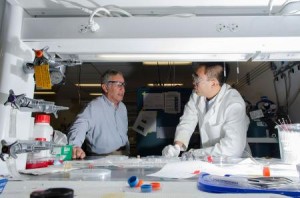
The development could help lead to safe, efficient artificial photosynthetic systems that replicate the natural process of photosynthesis that plants use to convert sunlight, water, and carbon dioxide into oxygen and fuel in the form of carbohydrates, or sugars.
Source: Caltech
The Electrochemical Society’s Nate Lewis is leading some pioneering research at Caltech with the vision of efficient, affordable, and effective renewable energy sources.
Dr. Lewis, an active member of ECS since 1982, has designed a novel electrically conductive film – which has the potential to result in the development of devices that can harness sunlight to change water into hydrogen fuel.
(Take a look at his plenary lecture on sustainable energy technology he gave at a past ECS meeting.)
“We’ve discovered a material which is chemically compatible with the semiconductor it’s trying to protect, impermeable to water, electrically conductive, highly transparent to incoming light, and highly catalytic for the reaction to make oxygen and fuels,” said Dr. Lewis.
He and his team have developed a process that allows the solar-driven production of fuel to be performed with record efficiency, stability, and effectiveness.
This from AZO Materials:
This latest breakthrough could result in the development of safe and efficient artificial photosynthetic solutions, also known as artificial leaves or solar-fuel generators. These systems simulate the natural photosynthesis process, which is used by plants to change sunlight, carbon dioxide, and water into fuel and oxygen in the form of sugars or carbohydrates.
The leaf includes the key components of a single membrane and two electrodes – photocathode and photoanode.
In the past, researchers have attempted to develop a coating such as this film, but have failed.
“You want the coating to be many things: chemically compatible with the semiconductor it’s trying to protect, impermeable to water, electrically conductive, highly transparent to incoming light, and highly catalytic for the reaction to make oxygen and fuels. Creating a protective layer that displayed any one of these attributes would be a significant leap forward, but what we’ve now discovered is a material that can do all of these things at once,” said Dr. Lewis.
The paper entitled, “Stable solar-drive oxidation of water by semiconducting photoanodes protected by transparent catalytic nickel oxide films,” was published in the journal Proceedings of the National Academy of Sciences.
Make sure to join Dr. Lewis and other brilliant scientific minds by becoming a member of ECS today!
Don’t forget to head over to the Digital Library to read more of Dr. Lewis’ research, including this paper of solar fuel generating devices!


